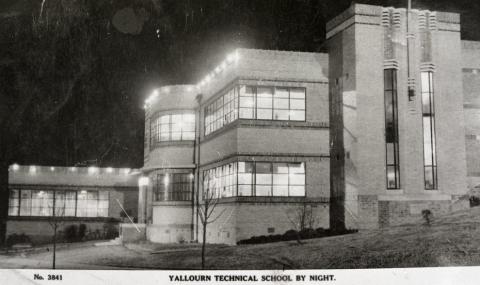The following article was unearthed in the ‘Gippsland Times’ and is in relation to re-training of workers for wartime employment in the essential services of munitions (weapons / ammunition) manufacture.
By 1940, Australia was on a war footing and many industries across the nation were gearing up to supply the needs of the armed forces. In the story below, men (women are not mentioned in the article) were being recruited from across Gippsland for re-training at the Yallourn Technical School for employment in the rapidly changing and expanding munitions industry.
The footnotes, provided with this story, attempt to give some background to the sombre times, the training program at the Yallourn Technical School and the production of munitions for the Australian armed forces in that period.
Furthermore, it is hoped that younger readers may come to appreciate how Australia’s entry into the war had far-reaching consequences upon the nature of industry and work in Australia; and that, some seventy-eight years ago, Yallourn Technical School played a meaningful role in the national war effort.
AUGUST 19TH 1940 GIPPSLAND TIMES PAGE: 4
MUNITION MANUFACTURE
Classes Commence at Yallourn
In connection with the Commonwealth Government’s technical training scheme for machinists and fitters, twenty men commenced a full-day 44-hour week course on August 12 at the Yallourn Technical School.
The training period is for approximately six months and on the completion of the course, the men will be transferred to munitions factories.
The instruction will be carried out by members of the school staff, Mr. J. Lonsdale will conduct the practical training. Mr. A. Miller the theory, and Mr. C. Jones the engineering drawing.
As the Education Department is unable to supply an additional instructor to carry out the normal teaching duties of Mr. Lonsdale, the members of the staff have agreed to accept additional teaching load as a contrition toward the Government War effort.
Any men over the age of twenty-one years, who have had some practical experience as fitter assistants or in garages, and are desirous of entering a Defence munitions training, should seek an interview with the Principal of the Yallourn Technical School on completion of the training of the first
group. It is contemplated that further groups will be established.
FOOTNOTES
1. Yallourn Technical School was one of five provincial/ country centres involved in the wartime training program; and the others were Geelong, Ballarat, Bendigo and Castlemaine.
2. The origins of basic technical schooling in Yallourn can be traced back to 1928. The official opening of the Yallourn Technical School building (on the corner of Latrobe and Railway Avenues) in 1936 signalled a new era for trade training in Gippsland. Within a short space of time, YTS became a highly valued and respected institution for training workers in the power, building and other key industries.
3. Mr C. H. Beanland was the Principal of Yallourn Technical School in 1940. Other members of staff in that era of the school included: J. Hewitt, A. Wade, A. Wilson, C. Jones and A. Miller (see above).
4. Mr Beanland served as the Principal of Yallourn Technical School from 1932 until 1943; and he was succeeded by Mr E.L. Willison (who held the position until 1947).
5. It is believed that while the men were re-training at Yallourn (and other centres) they received the Federal Award (the basic wage) which amounted to £4/4/0 (i.e. four pounds and four shillings - which equates to approximately $342 in 2017). The basic wage for women was set at £2/1/0 in November 1940.
6. The shortage of skilled workers, during World War: II in Australia was severe in such fields as: tool-makers, gauge-makers, fitters, turners and machinists.
7. It seemed that Yallourn was placed perfectly to be part of that national training scheme because of: (i) the large number of skilled tradesmen working at the SECV establishments in the Latrobe Valley and (ii) the existence of the Yallourn Technical School with qualified staff, tools, machinery and resources.
8. The training scheme was introduced in June 1939 and within a year, some 700-800 men had completed the required training and were working in munitions factories.
9. The main munitions factory (in Victoria) in that era, was situated at Maribyrnong.
10. In June 1941, the Commonwealth Government also announced the construction of an ordnance (i.e. armaments /military equipment) factory at Bendigo.
11. One newspaper report said that some technical schools in Melbourne were operating on a 24-hour a day basis in training men for the essential trades. There is no evidence that the Yallourn Technical School operated along such lines.
12. In a speech related to the national trade training programs (such as were being undertaken at Yallourn) the then-Prime Minister of Australia, Robert Menzies said…
"The valuable training work which is being carried out by the States through their technical schools and colleges is fully recognised and greatly appreciated by the Government….last September (it was) estimated that the training of 500 tool-makers and 2,000 tradesmen-mainly first-class engineering machinists and fitters-was needed immediately.“ Source: ‘Morwell Advertiser’ August 19th 1940.
13. It is difficult to ascertain how many women, who lived in Yallourn, actually gained work with the SECV and other nearby industries during those years. However, a local example of the changing role of women in the workforce was be found in the ‘Morwell Advertiser’ in January 1943…
“…the A.P.M. are in need of the services of three women supervisors and by advt (advertisement) invite applications. The jobs are shift work ones. See advt.” 14th January 1943 Page: 6
14. World War : II was a catalyst for the advancement of women into what had been regarded as ‘male dominated occupations.’ In the five years of international conflict (with so many men being enlisting in the armed forces and serving overseas), the nature of work for women underwent substantial changes…
“By 1942, the tides of war had shifted to Australia's doorstep and roles changed out of sheer necessity. Australian women entered the workforce in unprecedented numbers and were even allowed to take on 'men's work'. These were jobs for the war, not for life. Women were paid at lower rates than men and expected to 'step down' and return to home duties after the war.” Source: Australia.gov.au website.
THE END
The above story is part of an on-going project regarding the history of Yallourn. The story was researched and written by Roger Spaull and presented and posted by Julie George for the Virtual Yallourn website in August 2018.
The above article from the ‘Gippsland Times’ newspaper has been faithfully reproduced. The only amendments to the original copy are to the font style, font size and spacing, so as to enhance the article for purposes of posting on the Virtual Yallourn website.

